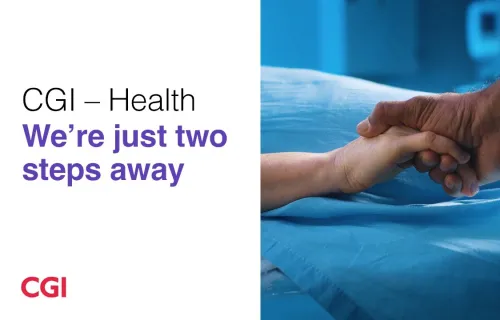“It’s the constancy of the CGI people that stands out for me. The key players have been involved for a long time and know the system intimately, so there’s no learning curve and they quickly recognize what has to be done.”
Clarence Woloshyn, Director, Systems and Client Support Services, Saskatchewan Health
Operating under the province’s health credo – Healthy People. A Healthy Province. – the Drug Plan and Extended Benefits Branch of Saskatchewan Health leads the development of drug plan policy for the province and provides benefits to eligible Saskatchewan residents by promoting cost-effective drug therapy and subsidizing the cost of quality pharmaceutical products of proven therapeutic effectiveness. All residents of Saskatchewan are eligible for benefits except those groups covered under other programs such as First Nations & Inuit Health, Department of Veteran Affairs, Royal Canadian Mounted Police, Canadian Forces, Worker's Compensation and Federal Penitentiaries.
The Challenge
Saskatchewan’s Drug Plan benefits process is managed with the help of a number of different information technology systems. Foremost is the Prescription Drug Claims Management System (PDCMS), a Web-based claims adjudication and reimbursement system administered by the Branch and used by the nearly 400 drug stores and pharmacies across the province to calculate a deductible on drug costs – which the citizen pays at the point of dispensing – and to submit a request for reimbursement for the balance. Additional applications – the Saskatchewan Drug Formulary and the Health Canada Database – complement the PDCMS by managing drug-related information, including what drugs can be covered, the manufacturers, the drug compositions, the prices, trade names and so on.
In addition, Drug Plan staff use a variety of other systems within the Branch to manage extended drug benefits programs, such as a Palliative Care Program; a Special Beneficiary Program to cover the cost of drugs required by those with certain chronic diseases; an Exception Drug Program covering special drugs prescribed when first-line drug therapy is ineffective; and Emergency Assistance and Special Support Programs to provide additional coverage for those with low incomes.
These diverse programs add up to a complex and dynamic computing environment that presents significant challenges to the Drug Plan and Extended Benefits Branch – multiple systems that need to be operated and maintained, a widely dispersed user community that needs to be supported, and software that needs continuous enhancement in response to changes in technology and new requirements driven by changing Drug Plan legislation.
These challenges are further compounded by the need to keep the Drug Plan system synchronized with emerging provincial and national healthcare initiatives, especially those pertaining to the rapidly increasing adoption of the Electronic Health Record (EHR).
The Strategy
Since building these custom applications for SaskHealth in 1989, CGI has maintained an extensive relationship with the Drug Plan, providing a strong project team and a complete suite of services – from hosting the PDCMS system and providing help desk support, to ongoing application maintenance and support for the PDCMS and other Drug Plan applications. CGI also develops enhancements for the software and provides consulting on how best to leverage existing systems to address emerging healthcare initiatives
“CGI’s lifecycle set of services has enabled us to operate and maintain a stable Drug Plan systems environment,” says SaskHealth’s Clarence Woloshyn, Director, Systems and Client Support Services, Drug Plan and Extended Benefits Branch.
The PDCMS, a real-time online system, is hosted and operated by CGI, on behalf of the Drug Plan, from CGI’s Regina data centre. There, dedicated CGI technical and business analysts provide hardware and software system monitoring, management and enhancement services, as well as liaising with SaskHealth’s Health Information Solutions Centre (HISC), which works with telecos such as SaskTel and Access Communications to provide the network connections to pharmacy locations province wide.
Acting as the first point of contact for any system problems, CGI also provides a 24x7 Help Desk that directly handles 85% of calls from pharmacists using the HCMS. After diagnostics are performed on the remaining problems by the Help Desk agent to isolate the cause, the problem is either handled by the CGI application support team or passed to the HISC for network problem resolution.
“I like how they respond quickly,” claims Woloshyn about how problems are handled by the CGI Help Desk. “CGI also provides services to the banking industry, so they know the importance of quick responses,” he adds.
Working closely with Drug Plan business analysts to define requirements, the CGI application development team assigned to SaskHealth provides ongoing enhancements to the Drug Plan’s suite of applications in response to problems passed from the Help Desk and changes in provincial legislation governing the Plan. In addition, enhancements are made to leverage major new technologies and to integrate the Drug Plan with other provincial healthcare and EHR initiatives. To achieve Y2K compatibility and address a mounting hardware support problem, for example, the CGI developers implemented a major enhancement to the PDCMS that replaced a legacy front-end POS devices with a complete new Web-based interface for pharmacists.
More recently, the CGI development team tackled the Drug Plan’s Enhanced Collection of Prescription Information (ECPI) initiative that will allow the PDCMS to collect and retain drug history information for all citizens, irrespective of whether they are covered by Drug Plan benefits or not. This major enhancement required the CGI team to exclude these new ‘capture only’ transactions from the financial-related program logic in nearly every component of the system related to the ‘capture & reimburse’ transactions for which the system was initially designed.
Commenting on the application development and support the CGI team provides, Clarence Woloshyn says that what stands out for him is that, “The CGI team has been around for a long time, so they’re very effective at what they do.”
The Technology
- Database: IDMS/R, Microsoft SQL
- Networks: TCP/IP, SNA
- Server & mainframe operating systems: MVS, Windows 2000 Server
- Programming Languages: Cobol, 4GL/GUI (.NET)
- Web Tools: FrontPage, Transaction Server, DNA, IIS, HTML, ActiveX, VBScript
The Results
The CGI-developed PDCMS system processes nine million ‘dispensing events’ per year, valued at $340 million. The speed and accuracy with which the PDCMS processes those claims is of considerable benefit to Saskatchewan pharmacists, who get quickly and properly reimbursed. The CGI Help Desk delivers a valuable service to the pharmacists as their first point of contact and a starting point for timely problem resolution.
“CGI is helping us achieve our goal of processing claim submissions within three seconds,” explains Woloshyn. “We know we’re meeting that goal because the pharmacists have never been reluctant about letting us know when the system is not performing properly.”
The PDCMS system is expected to handle an additional 3 million ‘capture only’ events per year once the ECPI program is in full gear. The PDCMS interface support and specifications that CGI is providing to pharmacy software vendors as part of the ECPI project, is helping them change their software to automate the new ‘capture only’ transactions.
“We continue to be extremely satisfied with our ongoing relationship with CGI,” exclaims the Drug Plan’s Clarence Woloshyn. “Their team is very flexible and always ready to step up to challenges, and the quality of what they do is always high,” he explains.
As SaskHealth prepares to roll out its new Pharmaceutical Information Program (PIP), CGI is playing a significant role in helping the Drug Plan assess how best to integrate the Drug Plan systems and share information with the new PIP.
“CGI is acting as a trusted advisor in helping me plan how to leverage our existing systems and the valuable drug history data we’ve already collected as we move forward to meet the needs of these new initiatives,” Woloshyn concludes.
Contact us for more information




